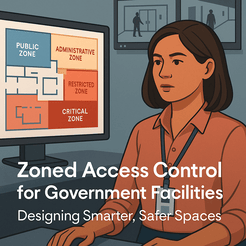
When it comes to securing government buildings, not every door should open for every person.
City halls, courthouses, police stations, public works facilities—they all serve different functions, and they often share a single space. That’s where zoned access control becomes essential. Instead of treating the building as one block of “locked or unlocked,” zoning divides your facility into manageable, secure areas—each with its own rules, access privileges, and purpose.
At SSP, we’ve helped dozens of municipalities rethink their access control strategy using a zone-based approach. In this article, we’ll break down what zoned access control is, why it matters, and how you can implement it to protect both people and infrastructure—without restricting public access where it’s needed.
k
k
What Is Zoned Access Control?
Zoned access control is a method of dividing a building into functional security zones, each with its own access policies. Instead of giving staff (or the public) building-wide access, you assign them only the permissions they need based on their role, location, or time of day.
Common security zones in government buildings include:
| Zone | Example Areas | Access Level |
|---|---|---|
| Public Zone | Lobbies, public meeting rooms, payment counters | Open during business hours |
| Administrative Zone | Offices, HR, finance | Authorized staff only |
| Restricted Zone | IT closets, evidence storage, utility rooms | Limited staff or escorted access |
| Critical Zone | Police armories, server rooms, emergency ops | High-security clearance only |
This layered approach allows you to maintain community accessibility while still securing sensitive spaces behind the scenes.
k
k
Why Zoning Matters for Government Security
Government buildings are complex by nature. A one-size-fits-all access strategy not only creates security gaps—it can overcomplicate operations and expose you to liability.
Here’s why zoning is essential:
1. Limits Risk Exposure
If every badge opens every door, one lost card or disgruntled employee can put your entire building at risk. Zoned access ensures that no one has more access than they need.
2. Improves Emergency Response
In a lockdown or evacuation, you can quickly lock down high-risk zones, allow egress from public zones, and enable first responder override access where necessary.
3. Supports Multi-Department Buildings
Many municipal buildings house multiple departments: police on one floor, city administration on another, maybe even a court or utility office in the same structure. Zoning ensures each group operates independently—without stepping on each other’s security protocols.
4. Enables Auditability and Compliance
With zone-based access logs, you can track who entered which area and when, supporting compliance with CJIS, NDAA, FIPS, and internal policies.
k
k
How to Design an Effective Access Control Zoning Plan
Zoning your facility starts with a site assessment and a clear understanding of how each space is used. Here's what to consider:
1. Map the Building into Zones
Start by identifying:
-
Public-facing areas
-
Staff-only workspaces
-
High-value or high-risk rooms
-
Emergency egress paths
2. Define Roles and Permissions
Think about who needs access to what:
-
Does IT need access to administrative areas but not courtrooms?
-
Should janitorial staff have after-hours access to public areas but not to secure offices?
SSP helps government clients build access profiles by role, department, and shift.
3. Apply Time-Based Restrictions
Some areas should only be accessible at certain times. With modern access control platforms, you can:
-
Restrict vendor or contractor access to specific hours
-
Lock down courtrooms after public hours
-
Automatically open/close public service counters
4. Integrate with Surveillance
Pair your access zones with camera coverage to get real-time alerts if:
-
A door is forced
-
A badge is used at the wrong time
-
Multiple access attempts fail in a restricted zone
k
k
Real-World Example: Zoning in Action
Problem: A city government was using a single badge system that gave all staff access to all areas—including sensitive utility controls and evidence rooms.
Solution: SSP implemented a zone-based access control system across their city hall, police department, and records office.
-
Administrative staff now have access to shared workspaces, but not the evidence locker.
-
Police staff can enter critical areas, while their credentials don’t unlock HR files.
-
Contractors receive temporary, time-limited access to only the zones they need.
Result: The city improved security, passed its compliance audit, and saw a reduction in unauthorized access attempts within the first 30 days.
k
k
Building a Smarter, Safer City—One Zone at a Time
Zoned access control isn’t just about technology—it’s about trust, accountability, and resilience. By taking a smarter, layered approach to entry management, government agencies can better protect their facilities, staff, and citizens—without losing the openness that defines public service.
Ready to Rezone Your Security?
See how SSP helps municipalities protect their people and infrastructure with zone-based access control strategies.
Contact us today for a security assessment or system consultation.


